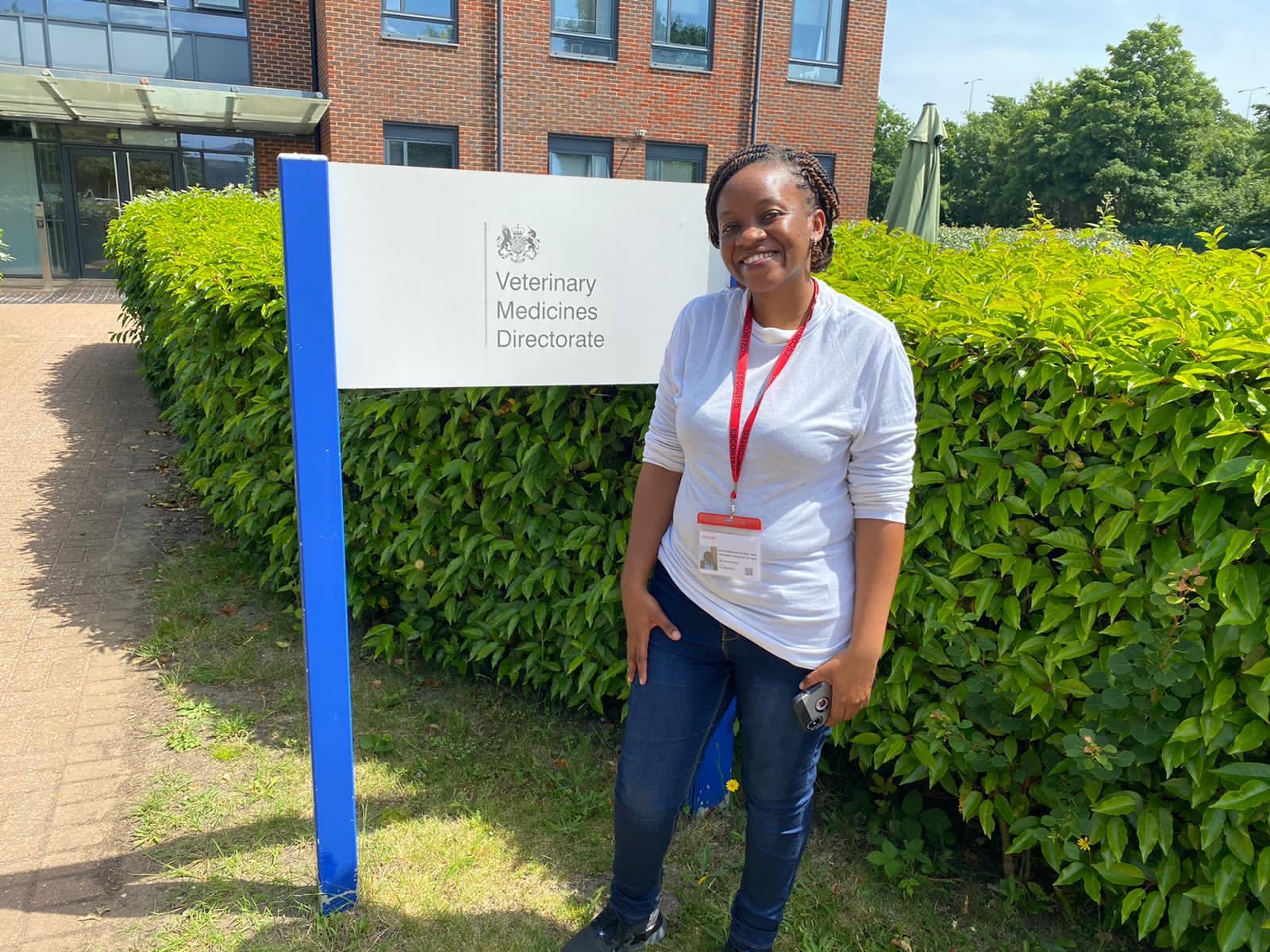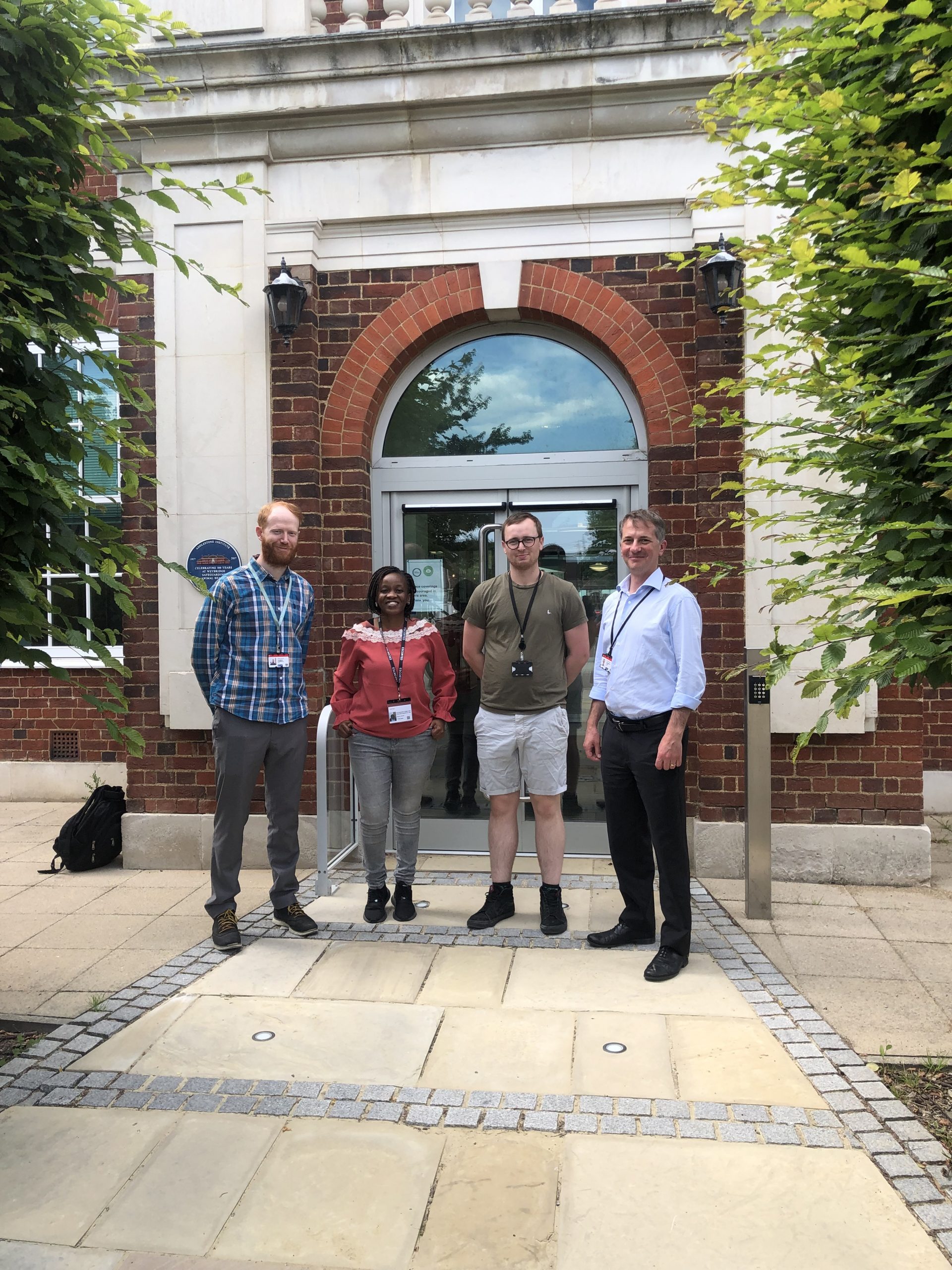In April 2022, the Commonwealth Pharmacists Association (CPA) held the first stakeholder meeting since the start of the pandemic. Representatives from 10 African countries joined for training, networking, sharing and learning activities in Entebbe, Uganda.
Lessons learnt at VMD: AMR in a 'One Health world'
As a Veterinary Investigations Officer at the Ministry of Agriculture in Zimbabwe, Kudzaishe Vhoko-Tapesana joined the Fleming Fund fellowship scheme in May 2021. Hosted by the London School of Hygiene and Tropical Medicine (LSHTM), Kudzaishe’s fellowship advances her professional development while supporting country efforts to improve surveillance of antimicrobial resistance (AMR) in animal health.
As part of her training at the LSHTM, the fellowship scheme offered the opportunity of a two-week placement at the Veterinary Medicines Directorate (VMD) in London. Here, Kudzaishe learnt how AMR animal health surveillance research and policy is conducted in the UK and shares an account of her “eye-opening and life-changing” experience at VMD.

Fleming Fund fellow, Kudzaishe at the VMD HQ in London during her two-week placement.
AMR and One Health
Through my postgraduate training in One Health at the University of Pretoria in South Africa, I developed an interest in solving health-related issues using holistic approaches, building upon my prior experience of zoonotic diseases.
This opened my eyes to the growing AMR problem that we often encounter as veterinarians, where some infections in animals are harder to treat; potentially resulting in greater risk of disease spread.
In Zimbabwe, animals are often exposed to vast amounts of antibiotics through mass farming practices for human consumption and contaminated environments. The training gave me an opportunity to grow as a One Health practitioner and epidemiologist, collaborating with global partners to tackle this vast and complex problem.
Contributing to the solution
As an aspiring epidemiologist, I wanted to help implement One Health programmes on the back of my research. My previous training improved my AMR knowledge and taught me how to better contribute to the solution, as we formulate a sustainable AMR surveillance strategy for our work in Zimbabwe.
Part of the in-country research I have been involved in includes developing and implementing a pilot project for AMR surveillance in poultry, offering recommendations for the scaling up of wider surveillance efforts.
I wanted to train in AMR data management systems and data analysis and share this knowledge with my colleagues, working in collaboration to implement an AMR reporting guideline in animal health in Zimbabwe.
I also produced a report on lessons learnt at the VMD to share with my colleagues, and provide training based on this and other skills learnt through the fellowship.

Kudzaishe and colleagues at the UK Animal and Plant Health Agency (APHA), Roderick Card, Thomas Chisnall and Allister Davies at the VMD HQ in London during her two-week placement.
Field expertise
At the start of my VMD placement, I was warmly welcomed by members of the international team; but behind these smiling faces, they are carrying out serious and impactful work. With a mixture of face-to-face and virtual meetings at VMD, the one-on-one meetings allowed me to explore the work of each expert and engage with them directly.
I was invited to attend some executive meetings, where I discussed wider VMD and AMR work in the UK with VMD’s CEO and deputy CEO – guided by the introduction of frameworks such as the National Action Plan (2019-2024), and ‘Contained and controlled: 20-year vision for AMR’.
One meeting with the VMD Enforcement team highlighted the three areas that underpin drafting policy-related documents for monitoring antimicrobial residues in the food chain: scientific evidence, political engagement, and consideration for the method of delivery.
The VMD team are also involved in ensuring adherence to existing AMR regulations of biologicals such as vaccines, and pre/post-authorisation of pharmaceuticals. I was able to witness how antibiotic stewardship programmes, supply chain regulation, and pharmacovigilance (drug safety) played important roles in the fight against AMR.
Zimbabwe parallels
The engagements with the AMR Surveillance and Evidence team brought to light some parallels between Zimbabwe and the UK in AMR control and highlighted differences where lessons could be learnt.
In the UK, AMR surveillance falls into two broad categories, namely harmonised monitoring and clinical surveillance. Such veterinary antimicrobial processes are used for susceptibility tests.
Harmonised monitoring assesses zoonotic microorganisms and indicator bacteria such as E. coli, Campylobacter, Salmonella; and of late, trialling of Enterococci has been carried out – this monitoring is coordinated across European countries with standardised laboratory methods.
Clinical surveillance focuses more on animal health samples and is submitted for diagnostic purposes. The surveillance system is devolved but still contributes to studies of AMR trends in the UK - providing a snapshot of AMR in organisms causing disease in animals, including zoonotic organisms. Passive surveillance also assists in AMR stewardship programmes, and ResAlert, a risk-based management system for new or unusual AMR threats arising from animals, is used across both programmes.
Seeing how the animal health surveillance system is structured was instrumental to inform AMR surveillance in Zimbabwe and in also strengthening clinical surveillance with an easier and cheaper source of samples. While it carries inherent bias; the results are useful in highlighting trends in AMR in veterinary pathogens and guiding AMR stewardship programmes.
Carrot and stick
A prominent take-home message included the value of behavioural science in health sciences.
Knowing and understanding your stakeholders (groups of those with a vested interest in the outcome of AMR control interventions, such as farming associations and the wider agriculture sector) can be the difference between them complying or not complying with good practices.
There needs to be a balance between ‘dangling the carrot’ and ‘following the stick’. If the carrot works; the stick is not always necessary for regulators to use.
The UK champions this with industry-led optimisation of antimicrobial usage in several species such as beef cattle and pigs – with antimicrobial usage in food-producing animals on a general decline in the UK since 2014.
Starting point
Using practical and free software is also a good starting point in data management and analysis. It is not always necessary to use complicated systems; it’s better to start from what is easily understandable, usable, and available to get the message across.
Microsoft Excel: for example, can be used for data management and analysis, if specialised and customised AMR analysis software are unavailable. Scientific evidence is useful no matter the tools used to discover this; software can be built upon and developed into more sophisticated, robust systems as time goes on.
Cross-sectoral collaboration is also important in strengthening AMR surveillance and control. This can be through public-private partnerships or by finding ways of complementing efforts in other departments within the agriculture sector, such as those involved in medicines control and field surveillance of diseases.
Clear science
My one regret is that my fellow colleagues couldn’t join the VMD placement as additional in-country support. It was an insightful visit, which I would recommend to any professional involved in medicines regulations and AMR surveillance.
One of the applications of lessons learnt during this placement is to engage relevant stakeholders during my research, and in future work in AMR control in Zimbabwe. The scope of the work is immense and based on clear science.
My deepest gratitude goes to the VMD for opening their doors to learn from them. I hope to make a difference in my country and in my One Health career; using the acquired knowledge during my time here to benefit my ongoing research and support my peers back in Zimbabwe.
Part of this blog was initially published in the VMD blog website and can be accessed here.
More Like This
The Fleming Fund supported the recent antimicrobial resistance (AMR) lessons learning workshop in Douala, Cameroon.